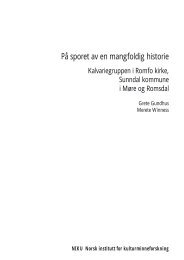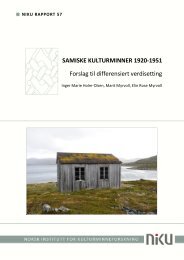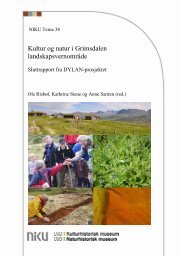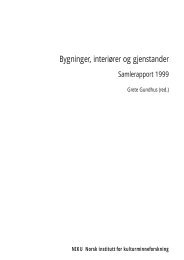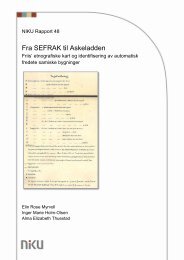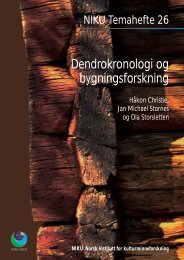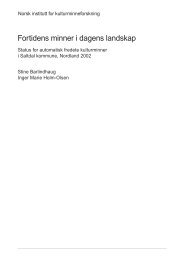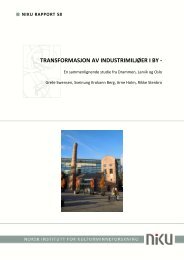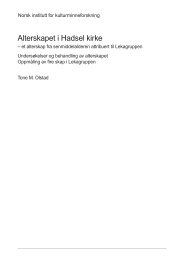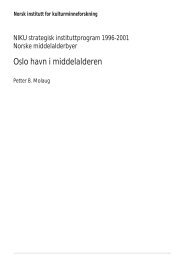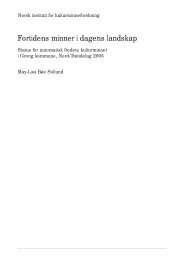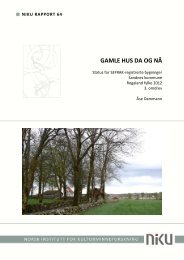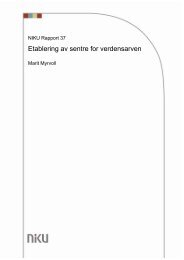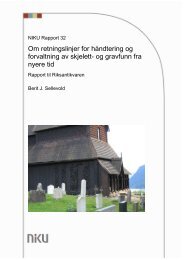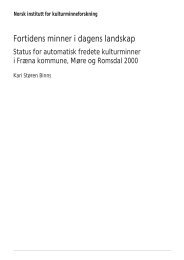NIKU Rapport 14
NIKU Rapport 14
NIKU Rapport 14
You also want an ePaper? Increase the reach of your titles
YUMPU automatically turns print PDFs into web optimized ePapers that Google loves.
<strong>Rapport</strong> <strong>14</strong> - 2007Den Norske Kirkes arkiver inneholder sparsomme opplysninger om etnisitet. Det er derforviktig at Den Norske Kirke har en dialog med Sametinget vedrørende sine framtidige planerom gjenbruk eventuell sanering eller avvigsling av kirkegårder. Dette for å unngå atautomatisk freda samiske kirkegårder og graver skades uten at dispensasjon er gitt fra rettemyndighet. Prosjektet Registrering av automatisk freda samiske kirkegårder er et bidrag ikartleggingen av samiske kulturminner både innenfor og utenfor dagens samiskekjerneområder. Prosjektet vil forhåpentligvis være til nytte for forvaltningen av dem i framtida.EmneordKulturminne, samisk, freda, kirkegård, grav, registrering, misjonering, typologi, kronologi,nordland, troms, finnmarkAbstractMyrvoll, Elin Rose. 2007. Sámi churchyards. A survey of legally protected Sámi churchyardsin Finnmark, Troms and Nordland counties. - <strong>NIKU</strong> <strong>Rapport</strong> <strong>14</strong>. 36 pages. In Norwegian.Churches and churchyards form an important source of knowledge about beliefs, rituals andother essential parts of our cultural history. Information about legally protected churchyardsis, however, scarce in the National Sites and Monuments Record. The Directorate forCultural Heritage has therefore initiated a project where the aim is to record legally protectedchurchyards. This report presents Sámi churchyards, which are protected by law when theyare older than 100 years.Churchyards in municipalities with more than 25% Sámi inhabitants according to thepopulation census 1890 - 1900, were chosen for survey. They were all located in Finnmarkcounty and in the northern parts of Troms county. Furthermore, 28 churchyards in Nordlandcounty and in the southern and central parts of Troms County were surveyed. Thesechurchyards were located in municipalities which had 5-25% Sámi inhabitants according tothe population census 1890 - 1900. All in all 126 churchyards were surveyed. During thefieldwork GPS (Global Position System) was used to position the churchyards, and otherinformation was documented in accordance with the National Sites and Monuments Record.Norwegian colonization and the establishment of fishing villages along the coast of northernNorway started in the 13 th century. The Sámi living in these areas then came under theinfluence of the Norwegian church and the Christian religion. Therefore one must assumethat there may be Sámi burials in Christian churchyards from the 13 th century onwards. Theinfluence of the church on the Sámi became more intensive during the 18 th and the 19 thcenturies. This period started with the missionary Thomas von Westen and his missionarywork among the Sámi from 1716 -1723.The churchyards are thus associated with various events and periods from the mediaevalperiod onwards to around 1900. The localization and construction of the churchyards varyfrom the outer coast to the inland areas. They can also be related to different cultural zones,such as Sámi/Norwegian, Coastal Sámi /Inland Sámi and East Sámi. The fieldwork data formthe basis of a proposed chronology and typology of Sámi churchyards which divide them intofive main types.Sixteen of the surveyed churchyards had extensive damage or seemed destroyed. Othershad damages caused by reuse and neglect. Most Sámi graves older than 100 years do nothave a headstone. Some graves have a wooden cross, but most of these crosses are nowdecomposed or in a bad condition. Headstones, especially homemade headstones made of©Norsk institutt for kulturminneforskning, <strong>NIKU</strong> 4 Samiske kirkegårder



